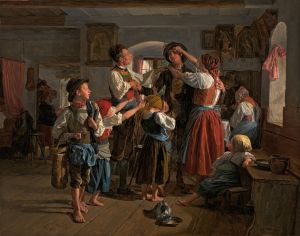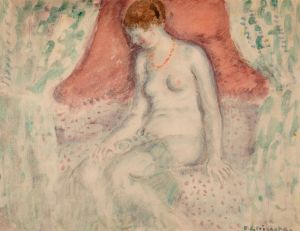
Junge Dame bei der Toilette
A hand-painted replica of Ferdinand Georg Waldmüller’s masterpiece Junge Dame bei der Toilette, meticulously crafted by professional artists to capture the true essence of the original. Each piece is created with museum-quality canvas and rare mineral pigments, carefully painted by experienced artists with delicate brushstrokes and rich, layered colors to perfectly recreate the texture of the original artwork. Unlike machine-printed reproductions, this hand-painted version brings the painting to life, infused with the artist’s emotions and skill in every stroke. Whether for personal collection or home decoration, it instantly elevates the artistic atmosphere of any space.
Ferdinand Georg Waldmüller (1793–1865) was an Austrian painter known for his contributions to the Biedermeier period, a style characterized by its focus on realism and detailed depictions of everyday life. One of his notable works, Junge Dame bei der Toilette (translated as Young Lady at Her Toilette), exemplifies his mastery in portraying intimate domestic scenes with meticulous attention to detail and texture.
The painting depicts a young woman seated at her toilette, engaged in the act of grooming or preparing herself. The composition reflects Waldmüller’s skill in capturing the subtleties of light, fabric, and human expression. The subject is rendered with a sense of realism that was typical of the Biedermeier aesthetic, emphasizing the beauty of ordinary moments and the refinement of bourgeois life during the 19th century. The setting is likely a private interior, with carefully arranged objects that contribute to the narrative and atmosphere of the scene.
Waldmüller’s work often highlighted themes of domesticity, morality, and the natural world, and Junge Dame bei der Toilette fits within this framework. The painting demonstrates his ability to balance technical precision with emotional resonance, making his works both visually striking and culturally significant. His attention to detail, particularly in the rendering of textures such as fabric and skin, showcases his dedication to realism and his deep understanding of his medium.
The exact date of the painting is not definitively documented, but it aligns with Waldmüller’s broader body of work from the mid-19th century. During this period, he was at the height of his career and was celebrated for his portraits and genre scenes. Waldmüller’s art often reflected the values and aesthetics of the Biedermeier period, which emphasized clarity, order, and a focus on the private sphere.
Today, Junge Dame bei der Toilette is recognized as an example of Waldmüller’s contribution to 19th-century European art. His works are held in high regard for their technical excellence and their ability to capture the essence of the time in which he lived. The painting is part of the broader legacy of Waldmüller’s oeuvre, which continues to be studied and appreciated for its historical and artistic significance.
Further details about the painting’s current location or provenance are not readily available.


















